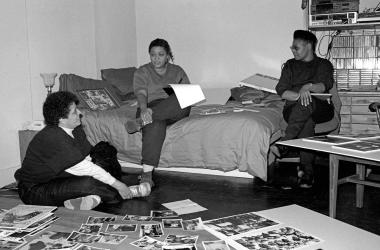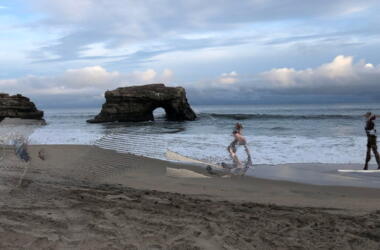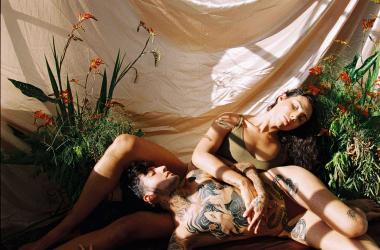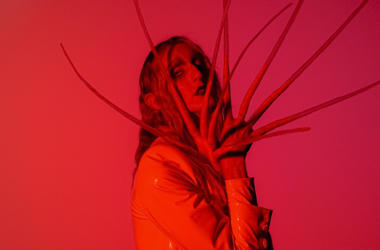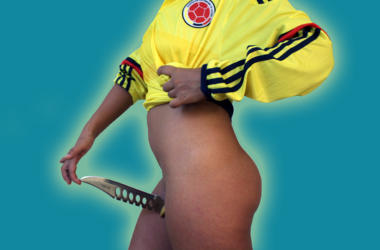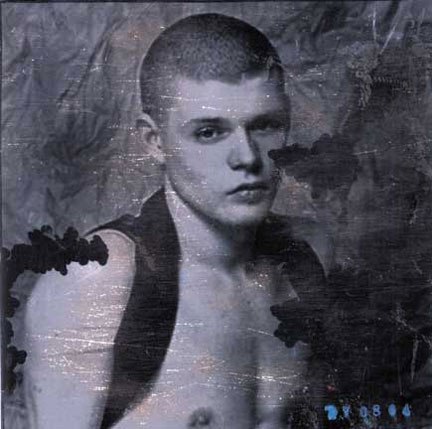
Image
PAST
21st CENTURY QUEER MEN: Artists on the Edge
Feb 18, 2005 - Feb 26, 2005
Artists: Jarrod Beck, Brian Riley, Marc Van Cauwenbergh
21st Century Queer Men Artists On The Edge: Jarrod Beck, Brian Riley, Marc Van Cauwenbergh by Mark Schulte and Tom Saettel
(from THE ARCHIVE: No. 15: Winter 2005)
For the first exhibit of 2005 Leslie-Lohman Gallery presents 21ST CENTURY QUEER MEN: Artists on the Edge to investigate how Queer art is being defined in the 21st Century. 21st CENTURY QUEER WOMEN, 3 Lesbian artists will follow in May-June 2005. The three artists selected for the exhibit-Jarrod Beck, Brian Riley and Marc Van Cauwenbergh each work with the male form and each have their distinct vocabulary. And although themes of abstraction, fragmentation and distortion abound in all their work, they are far more united by their constant probing, questioning and exploration. All seem to take on the sensual world–Riley with precious or pseudo-precious mementos, Beck with his gestalt of materiaLs and imagery, and Van Cauwenbergh with luscious paint, outrageous color, admittedly on a trek to find a new sensual language.
We had the opportunity to speak with each of the artists during or prior to the curatorial process.
JARROD BECK
Jarrod Beck’s latest work is an investigation into what the void can be. The larger pieces to be shown in 21ST CENTURY QUEER will be made in the gallery, work made in relation to the artist’s body. The work is about figure and landscape, with abstraction as the operative tool, or the way to mediate the two.
Jarrod was once able to describe his work in the following way: “The nature of my drawing is the idea that one draws different details of the body creating a travelogue of the body.” But the new work is far more inclusive: a dance, a choreography, making bodies-images, art work, by pouring elemental liquids such as Sumi ink, fluid acrylics, alkyd, shellac, wood stain and combining them with a plethora of collage elements which include his huge silk screens often of appropriated images.
Thin skins–stained translucent mylar–thin slices of light are mounted 2 inches from the wall allowing illumination and a voyeuristic view behind. By mounting the works on the wall and encouraging the viewer to peer through the surfaces the work becomes confrontational, relating to your own body: a shadow of a body, your body, or the stain of the body’s action. The long wall pieces reference Chinese scroll painting, the itinerary of the eye surveying nature, or the hand discovering flesh. Flaky skins, patterns of lace, referencing a topography, or aerial view of a landscape with distance and scale skewed and off balance further one’s immersion. Jarrod Beck does not give us a set fixed view of the world but invites us to dive in with him on his journey of discovery where volumes of Queer imagery, materials and intimacy all collide.
BRIAN RILEY
Brian is a young artist and, as such, was exposed to computers and “modern” technology at a far younger age than many of us. Brian likes to focus on living with technology and what that means. In this day of internet chatrooms and the easy availability of erotic and pornographic images via computer, Brian feels that he, along with many gay men today, has an erotic relationship with his computer. Computers have changed things drastically in the world of male-male sex.
Brian is also captivated with the concept of forming some new thing out of something that already exists. “We no longer have to accept the images that are out there, but can change them as we see fit,” says Brian. “I love to combine two separate images to create a new image, or put an arm where there was no arm previously.”
Indeed many of Brian’s “men” are not real men at all but rather composites. He can take the eyes of one model, the jaw of another, the hair of a third and body of a fourth and combine them to create a “new man,” distinct from the sum of his parts. The computer makes all this possible. Looking around his studio, the tattoo of a star which appears on the neck of one “man” shows up on the arm of another and the pec of still another. Seen alone, one would never suspect. However, seen together one begins to get hints of the manipulation.
Brian also likes the concept of creating history where there is no history. He often deliberately takes his images and cuts them up, scratches them, steps on them, adds dirt, dust, etc.
A series of images pressed on tin could fool all but an expert if found at a flea market. The images look old and time worn, which adds to their beauty. Yet these images, which speak to a history, in fact have none. In fact, these “men” never actually lived. They are all invented.
“I once completely fooled a friend of mine,” says Brian. “I created a series called Ghetto Vintage. I invented a Latino-looking man from composites. Then I made several different images of him in various poses, looking like polaroids. After that, I dirtied them up and stuck them together with adhesives. I met my friend and showed her the images, making up a story of having found them in a garbage can near some housing project. We conjectured that the man must be the boyfriend of some girl living in the projects and that she took these photos of him. After they broke up, she threw them out. However, now I, a gay man have found these old photos and they will have a new life as part of my erotic repertoire. She bought it hook line and sinker, never suspecting that everything about the images was fake.”
MARC VAN CAUWENBERGH
Belgian artist Marc Van Cauwenbergh developed his own painterly vocabulary out of a boredom with representational art. Marc needed an art which could encompass what the body means to him. Marc paints the human form. In the work LLGAF will be showing this is more evident than in some of Marc’s paintings but they all spring from probing the same issues-how to create images which have a psychological expression, and interior state rather than an exterior state. Marc deals with issues of crowdedness, closeness, the ability and/or inability to connect, intimacy and chaos. These are all dealt with in formal, painterly terms–how the paint fills the field, crowds the edges or overlaps.
But the paintings are also about figures, bodies,a strong sensual essence. Marc does not create a silhouette and fill in the volumes, rather he starts with the volumes and the contours come or do not come as they are needed or not, He arrives at a beautiful external reality-the paintings–monumental abstracted figures.
Marc’s color is a sensual delight as well. You almost re-experience his expectant breath choosing and combining his most unexpected colors. You feel his master’s edge in this fine colorist’s creations.
Three artists, three visions defining our Queer vision in the 21st Century. Artists will continue to explode in the 21st Century in ways that may seem quite “queer” to us today and the 22nd Century Queer will be creating art we cannot even dream of…yet.
21ST CENTURY QUEER MEN opens Tues. Jan 18, 2005 6pm and continues through Sat. Feb 26, 2005. Special thank you for support from HX Magazine.





